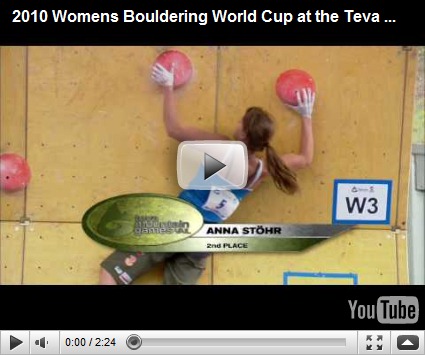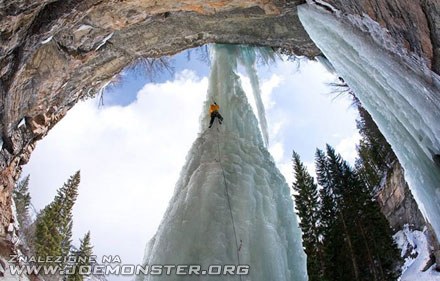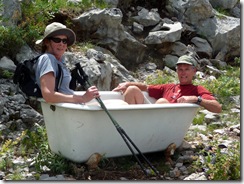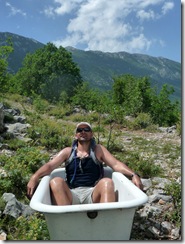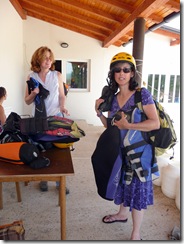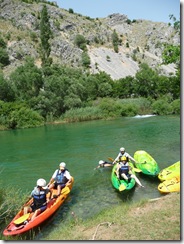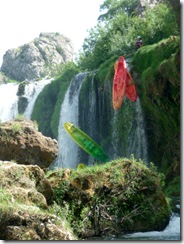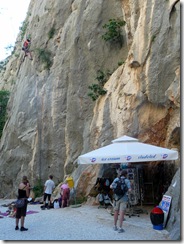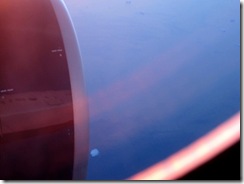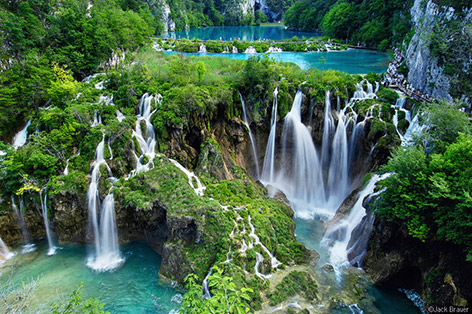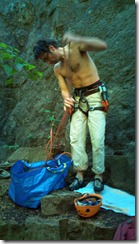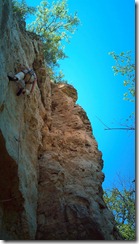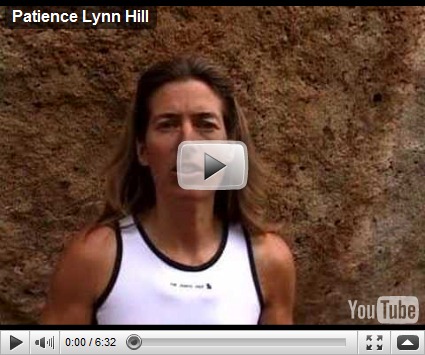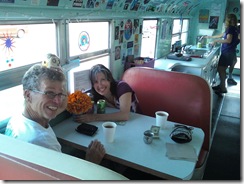 It wasn't a technical climb but never forget that mountains are big. Roman, Emily, Kamil and I began our hike in the center of the town below, Martin, Slovakia. The weather was great and the view was fabulous.
It wasn't a technical climb but never forget that mountains are big. Roman, Emily, Kamil and I began our hike in the center of the town below, Martin, Slovakia. The weather was great and the view was fabulous.
Wednesday, June 30, 2010
Martin'ski Hole'
 It wasn't a technical climb but never forget that mountains are big. Roman, Emily, Kamil and I began our hike in the center of the town below, Martin, Slovakia. The weather was great and the view was fabulous.
It wasn't a technical climb but never forget that mountains are big. Roman, Emily, Kamil and I began our hike in the center of the town below, Martin, Slovakia. The weather was great and the view was fabulous.
Monday, June 28, 2010
What Bouldering Grade Is Everest?
That’s what one climber asks as kind of a joke. Here’s a thoughtful answer:
“I feel pretty confident in saying that the main obstacle to my climbing Everest is a large amount of money and time and not much else. It is remarkable that a climb which tested the limits of human endeavor in the 1950s is now essentially a tourist destination. A V12 in RMNP, while commonplace enough today, still demands a kind of commitment in terms of training and dedication that the average Seven Summitter doesn't require.”
Trad Climbing Video
In an era of sport climbers, and boulderers, Boulder Local Nellie Milfeld stands out as a talented and bold traditional climber. This short movie is brought to you by BlueWater Ropes, and features Nellie crushing "Arms Bazaar" a 5.12aR at Bells Buttress in Boulder Colorado.
Sunday, June 27, 2010
Moonbow
An article describing moonbows with predictions of best times to see them in Yosemite. And a short video of a moonbow and rainbow in Patagonia.
Saturday, June 26, 2010
Dubrovnik Tour
Or as we affectionately call it “D’ Town.” Old city founded in the 7th Century. It’s one of the best preserved walled cities in the world. We took a walking tour on top of the wall which surrounds the city.
Watch Marko’s legs as they become “El Busto.” Listen to Barbara and Bill’s annoying morning church bells.
Thursday, June 24, 2010
Wednesday, June 23, 2010
Skiing K2
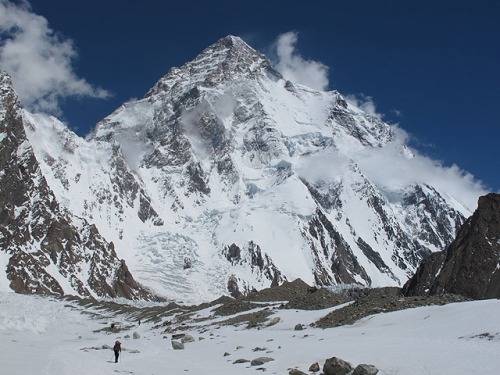 This blog describes an attempt to ski down K2 – a 10,000 foot ski descent – which has never been done before. They just reached the base of K2 yesterday.
This blog describes an attempt to ski down K2 – a 10,000 foot ski descent – which has never been done before. They just reached the base of K2 yesterday.
Buttshotphobia
 For those of you going to the Black Hills next week, keep these photo tips in mind so you don’t have all your photos with butts in them.
For those of you going to the Black Hills next week, keep these photo tips in mind so you don’t have all your photos with butts in them.
FOCUS ON FACES
DEPTH OF FIELD
LEADING LINE
BE ORIGINAL
A Treatment For A Bad Ankle
If you’ve injured your ankle, this is a slightly different way to treat it:
“…two weeks of pampering for the goat and then a moment of bliss...a sweet is given to the goat as he stands on an alter surrounded by well wishers. At the end of the two weeks of pampering, as the goat chews the sweet while standing on the alter, a blade serrates his neck and sacrifices his life at the highest moment of satisfaction.”
I have not tried this…yet. But I’m thinking it might also work for climber’s elbow.
Tuesday, June 22, 2010
Paklenica Park
The mecca of sport climbing in Croatia. Tons of bolted climbs from 1 pitch to 20. We only bouldered a little bit here. We hiked up to a mountain hut for lunch and some homemade moonshine.
Kayaking Croatia
We did one day of kayaking on the Zrmanja and Krupa Rivers. The water is crystal clear.
Monday, June 21, 2010
Split, Croatia
Split’s the home of Diocletian’s palace. A guy who built his retirement home at the turn of the 4th century AD.
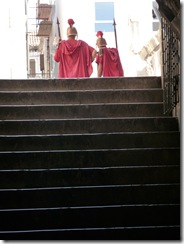 Here are some Roman Centurions at the top of the steps.
Here are some Roman Centurions at the top of the steps.
The entry to the palace, has a great a rotunda for singing. As shown here by Lisa & Barb. (Watch Carl turn and walk away. There’s always a critic.)
And here are some professional singers in the same rotunda.
A hike in the nearby Dinaric Alps, came with with a handy bath tub to clean up in.
Friday, June 18, 2010
Hvannadalshnjukur
 Richard posted an account of the ascent of this peak in Iceland, a couple of weeks ago, this is a different spin, different experience, from Women's Adventure Magazine.
Richard posted an account of the ascent of this peak in Iceland, a couple of weeks ago, this is a different spin, different experience, from Women's Adventure Magazine.I’m a forty-three year old woman and I’m crying. Sniveling. Angry. Weak. I want to take my trekking pole and hurl it at the sturdier mountaineers in front of me, but they are too far ahead and that would require precision and more energy than I have left. On the positive side, I’ve managed to scale the highest peak in Iceland without impaling myself on my ice axe or yanking the seven other people, who were roped up to me earlier, into a crevasse.
Thursday, June 17, 2010
Wednesday, June 16, 2010
Kayaking Vrgada
A short video of our kayaking trip to the island of Vrgada off the Dalmatian coast of Croatia. (If your geography is spotty, Dalmatia is where the dogs come from,. That chase the fire trucks. Oh, you knew that. Never mind.)
The video quality is low because my connection was spotty. No, seriously, that’s the reason.
Monday, June 14, 2010
Rolling On The River - Croatia
Plitvice Park - Croatia
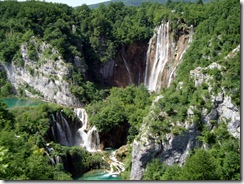 About 3 hours south of Zagreb, which is where we landed after Amsterdam, is Plitvice Park. It consists of 16 lakes (and a lot more waterfalls) that in a mountain range of dolomite and limestone. Because of this type of rock, the water has lots of calcium carbonate and that creates a blue green color. And the calcium carbonate combines with moss and algae to form travertine rock which is what stalactites in caves are made of. Here’s travertine which looks like a frozen waterfall. (It’s an outdoor stalactite, basically.)
About 3 hours south of Zagreb, which is where we landed after Amsterdam, is Plitvice Park. It consists of 16 lakes (and a lot more waterfalls) that in a mountain range of dolomite and limestone. Because of this type of rock, the water has lots of calcium carbonate and that creates a blue green color. And the calcium carbonate combines with moss and algae to form travertine rock which is what stalactites in caves are made of. Here’s travertine which looks like a frozen waterfall. (It’s an outdoor stalactite, basically.)
Paklenica Park
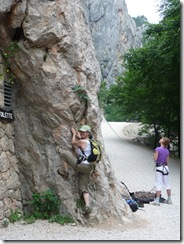 Today we hiked in Paklenica which is the mecca of sport climbing in Croatia. There are hundreds of bolted climbs including some right outside the bathrooms, like this one Lisa is bouldering on.
Today we hiked in Paklenica which is the mecca of sport climbing in Croatia. There are hundreds of bolted climbs including some right outside the bathrooms, like this one Lisa is bouldering on.
And this one which is right above the store selling ice cream and climbing equipment. More later.
Thursday, June 10, 2010
Practice Tip: Falling
This is from an article on Ukclimbing.com by Arno Ilgner here is the full article
We tend to practice falling, or anything stressful, to get it over with. This will not only delay our learning of the skill but will also cause us to learn it incorrectly. Our body will learn to tense up. Learning how to fall means we learn to remain relaxed while falling. Here is a learning-based approach to practicing falling.
1. Small increments:
Begin on toprope
First, simply hang on the rope and swing around.
Second, take toprope falls
Third, take lead falls
2. Gauge for learning: Comfort
First, stay at the same increment until you are comfortable
Second, you know you are comfortable when…
B: You’re breathing throughout the fall
E: You’re looking down during the fall
R: You’re relaxed throughout the fall
P: You’re arms are out; not grabbing the rope
3. Belaying: Giving a cushioned catch
First, do not progress to lead falls until your belayer learns how to give you a cushioned catch during toprope falls.
Second, a cushioned catch is: the belayer gives in to the pull when you fall. Your belayer should end up about five feet off the ground when your fall is ended. If he isn’t, then he will need to push off as the rope becomes taut. This will be a learning process for your belayer.
Croatia Part 1
 We left the Cities about 5PM and flew directly to Amsterdam. We were super excited.
We left the Cities about 5PM and flew directly to Amsterdam. We were super excited.
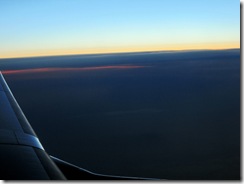 It never got completely dark – this shot over Hudson's Bay was the darkest.
It never got completely dark – this shot over Hudson's Bay was the darkest.
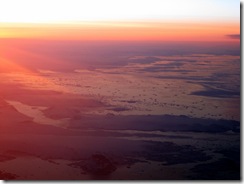 Most of the flight over was overcast. But, on the western side of Greenland, I got this shot of hundreds of icebergs.
Most of the flight over was overcast. But, on the western side of Greenland, I got this shot of hundreds of icebergs.
And this one of the plane’s engine just about to swallow an iceberg.
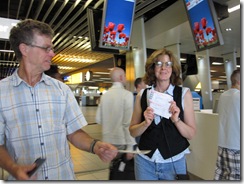 At Amsterdam, we found out that someone had mistakenly cancelled our flights to Croatia.
At Amsterdam, we found out that someone had mistakenly cancelled our flights to Croatia.
Than took two hours to re-schedule and a few hundred Euros.
we were so excited to get our new boarding passes.
 After a long plane delay, we arrived in Zagreb about 5PM. Tomorrow we head for Pltvice National Park and will be off the grid for about two days.
After a long plane delay, we arrived in Zagreb about 5PM. Tomorrow we head for Pltvice National Park and will be off the grid for about two days.
Density Training
 Climb Strong talks about training for “density”which is increasing your strength as well as endurance.
Climb Strong talks about training for “density”which is increasing your strength as well as endurance.
“In the nebulous world between pure strength and pure endurance, there is another answer. If you’re training on a bouldering or system wall, you might just consider training for density. In fact, if I could choose just one type of workout to use for climbing, this would be the one.”
Wednesday, June 9, 2010
We’re Off To Croatia
We’ll be in Croatia for about 10 days. We fly into Zagreb then go to Plitvice Lakes National Park.
View Croatia Trip in a larger map
A preview of a Nature show on Plitvice Lakes National Park.
Tuesday, June 8, 2010
It’s Zach
 Zach Bramel On Side Effects 5.10d
Zach Bramel On Side Effects 5.10d
From mountainproject.com description of this climb on the link above:
“For the brave, the crux move on the roof sets up reasonably well for a figure-4. Even with a bolt at your waist, it's a little heady though.”
Hiking The Appalachia Trail To Africa
There’s a plan to extend the Appalachia Trail across the Atlantic
“A few hundred million years ago, after the continental plates of Europe and North America collided, they broke up and drifted toward their present locations, Anderson said. The remnants of that colossal crash formed mountains that now rim the North Atlantic.
On the west they're called the Appalachians. On the east, they're known by a variety of names - from the Western Alps in Norway to the Caledonides on the British Isles and Atlas Mountains in Morocco, where they end.
As it's now shaping up, the IAT will brush the east coast of Greenland before picking up in Ireland and Northern Ireland, Wales and Scotland. It will resume on the mainland in Norway and proceed south through France, Portugal, nip western Spain and end in Morocco. Trails already exist along much of the conceptual route, planners point out, so participating countries in many cases can mark certain trail segments with the IAT sign to make it part of the network.”
I wish the planet would stop moving all over the place just settle down!
Ron & Fabrice At RW
Here’s a video of them climbing “Needles and Pins” and “Roof Burner.” (My new camera shoots in a green hue. I am returning it. I can adjust some of it out but not in some shots; that’s why Ron’s in B&W and Fabrice is in color. I left a little of the green in the first shot.)
Be Prepared To Have Impact
This article describes the damage climbers do to plants when they climb rocks on which plants grow. I kinda had already guessed that rock faces used a lot for climbing were not full of plant life.
"Most climbers try to be responsible, but they are prepared to have a certain level of impact."
So as a climber, you do impact the rock. Just try not to impact the ground when you fall.
Monday, June 7, 2010
Blue Bagging At The ‘Wing
Trad Climbing
I thought this had some nice shots of gear placements.
In an era of sport climbers, and boulderers, Boulder Local Nellie Milfeld stands out as a talented and bold traditional climber. This short movie is brought to you by BlueWater Ropes, and features Nellie attempting "Arms Bazaar" a 5.12aR at Bells Buttress in Boulder Colorado.
Sunday, June 6, 2010
Madagascar Stone Forest


So cool, I am not sure I believe it is real! More photos here. Here is some information about it from National Geographic.
Saturday, June 5, 2010
Lynn Hill On Patience
We posted this video about two years ago. On re-watching, I thought it was worth posting again.
The route she climbs is called “The Perfect Child.” I could only find a few references to it on the ‘net. It appears to be in the Henry Mountains in southern Utah. One of the most remote – and the last discovered – mountain ranges in the continental U.S.
She says in the video, you need “sensitivity to your center of gravity. If you’re feeling out of balance, you have to ask yourself the right question. Why?”
Canadian On Everest
A climber from Calgary just became the first Canadian to summit Everest without oxygen (and return safely.) He climbed from the Chinese side. He talks about the climb and his training for it here. I found this part of his interview most interesting:
“When we were up there, you’re passing dead bodies. There are eight of them on the route I did. I only saw three, which is three too many as far as I’m concerned. These people died doing exactly what I was trying to do. And they’re not dead in any dramatic fashion. They’re laying there with their arms curled up under their head like they’re taking a nap. There’s one Indian climber we called Green Boots, he’s been there since 1996 …. The way I justify in my own head, is that if I’m driving back from a ski trip and you see a white cross in the ditch showing where somebody died, I don’t think you change your driving. You think about it, but you don’t change your driving. The only difference in Everest is that the body’s still there because you can’t get them down.”
Friday, June 4, 2010
Weather Insurance
If you want to climb somewhere and you don’t want your trip to be ruined because it rains, for example, here’s an online service that sells weather insurance. I plugged in a 5 day period in June in the Black Hills, and specified that I wanted to be paid $100 for each day it rained more than .5 inch, for a total payment of $500. Insurance for that is $34.
The Magic Bus
Fridays at VE, the Magic Bus shows up with an extensive hot dog menu. As I waited for them to set up, I couldn’t help thinking:
"I'm so nervous, I just sit and smile (Too much, the Magic Bus).”
Finally, they let Liz, Lisa and me inside, where we enjoyed a tasty, healthful tube steak. Their menu is here.
Thursday, June 3, 2010
Climbing Hvannadalshnúkur
Here’s the Gear Junkie’s recent story of climbing the highest peak in Iceland Hvannadalshnúkur.
Wednesday, June 2, 2010
Avoid the Tangle
Tech Tips on keeping the rope free of your feet. Including the:
“Rule of Opposites
On wandering climbs, follow this simple rule: left is right, and right is left.”
How To Disrupt An Organization
These suggestions are from a 1944 manual put out by the OSS (precursor to the CIA) on how to sabotage the enemy’s war effort and delay production if you are working as a spy. How many of us still see these used today?
Organizations and Conferences (starting at page 32)
-
Insist on doing everything through "channels." Never permit short-cuts to be taken in order to expedite decisions.
-
Make "speeches." Talk as frequently as possible and at great length. Illustrate your "points" by long anecdotes and accounts of personal experiences. Never hesitate to make a few appropriate "patriotic" comments.
-
When possible, refer all matters to committees, for "further study and consideration." Attempt to make the committees as large as possible — never less than five.
-
Bring up irrelevant issues as frequently as possible.
-
Haggle over precise wordings of communications, minutes, resolutions.
-
Refer back to matters decided upon at the last meeting and attempt to re-open the question of the advisability of that decision.
Managers and Supervisors
-
Demand written orders.
-
"Misunderstand" orders. Ask endless questions or engage in long correspondence about such orders. Quibble over them when you can.
-
Order high-quality materials which are hard to get. If you don't get them argue about it. Warn that inferior materials will mean inferior work.
-
In making work assignments, always sign out the unimportant jobs first. See that the important jobs are assigned to inefficient workers of poor machines.
-
When training new workers, give incomplete or misleading instructions..
-
Hold conferences when there is more critical work to be done.
-
Multiply paper work in plausible ways. Start duplicate files.
-
Multiply the procedures and clearances involved in issuing instructions, pay checks, and so on. See that three people have to approve everything where one would do.
-
Apply all regulations to the last letter.
Friction Using Body Parts
 Tips on using “7 Neglected Body Parts” for friction in order to keep from falling or to get a rest.
Tips on using “7 Neglected Body Parts” for friction in order to keep from falling or to get a rest.
Like this head jam.
Knot of the Day
You see a stranger across a crowded room, there is an air of familiarity about him, and something intriguing. Well, that is how I feel about the knot. First off, I think I am into quick release knots because I have been biking with my feet clipped in! I think about release all the time. The familiarity… this guy looks like my much beloved prussick! That’s it!… perhaps they are cousins. Ok kids, get about the rope, give it a whirl and think of an application.


World Cup Bouldering At Vienna
Full results here. Split screen video of the finals below. It is interesting how some of the climber try to dyno to get a high hold while others heel hook or use their feet more. (At 4:33, I found something I could actually do; run out with a brush to clean the holds. I could do that.)
Women & Rock Climbing
As usual, I was very surprised to read in this article, that women can excel at rock climbing. Who knew?
Another surprise, was the number of climbers in the U.S. stated in the article. I thought there were fewer.
“The Outdoor Foundation’s national survey shows that almost 2.3 million people tried rock climbing, ice climbing or mountaineering in 2008.
Duane Raleigh, the publisher of Rock and Ice, said that his magazine’s surveys showed that about 70 percent of the regular climbers in the United States were male, with about one million people participating over all when those who try it only once are excluded.”
50 Classic Climbs
This couple is attempting to climb all of the routes in the book “50 Classic Climbs of North America.” (Listed here too.) None of them are in the upper Midwest. One of them, is on CastletonTower in Utah. Video of them climbing that is below. From their website:
“No married couple has attempted such an endeavor to climb over 164,000 vertical feet of technical terrain on a road trip that will cover over 25,000 miles.”
Tuesday, June 1, 2010
Don’t Do What They Do
Dave Graham talks about role modeling:
“Remember that being a successful athlete, no matter which arena you compare yourself in (peers, amateur, professional) by definition means doing what other people wouldn’t. Lots of people model their technique, training and tactics on what their peers are doing. But if you want to get better than them, they are exactly the wrong people to look at…So wake up! The greatest success you can hope for by doing what everyone else (in YOUR world of peers) does is to assimilate the same level of mediocrity they have.”
Siberian Hitch

This is also called a "slippery figure of eight". I would call it "almost a figure 8".
It is a quick release hitch often used by Ray Mearsduring his bushcraft television series. The hitch is known for the ease in which it can be tied even whilst wearing gloves or mittens in cold climates. This hitch is also slipped and therefore can be released by pulling the short end of the rope.
That all sounds good although I am not sure when I would like to be quickly released, but I am sure there would be such a circumstance. What do you think?



